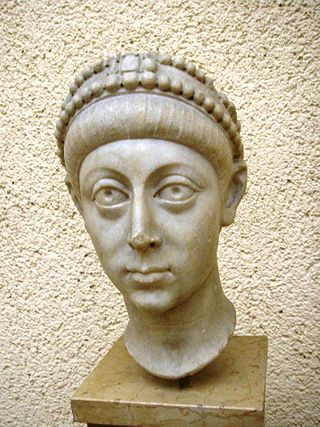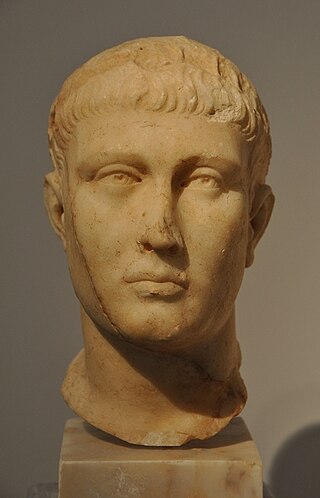
Rufius Probianus ( fl. 400 AD) was a vicarius of the Late Roman Empire. He is known from an ivory diptych on which he appears with his right hand lifted in an oratorical gesture to indicate that he is either speaking or has the right to speak. [1]

Rufius Probianus ( fl. 400 AD) was a vicarius of the Late Roman Empire. He is known from an ivory diptych on which he appears with his right hand lifted in an oratorical gesture to indicate that he is either speaking or has the right to speak. [1]
It is not known for certain when the ivory diptych of Rufius Probianus was created, it is believed to be dated to between the years 396 AD and 416 AD. [2] However in the year 384 the emperor of the eastern empire, Theodosius I, decided to enact a law that forbid the issuance of gold and diptychs made of ivory by anyone other than a consul. There is evidence of diptychs being created that appear to be in opposition of this law and many scholars believe that the law was ignored, or that special permission was given to allow the creation of these ivory diptychs. Rufius Probianus was but one example of a lesser official issuing an ivory diptych as he was only vicarius of the city of Rome, a station well below that of a consul. Another famous example of a Roman official who presented diptychs in opposition of the law was Aurelius Symmachus who issued diptychs to his son to celebrate his achievements. [3] [4]
Despite diptychs presumably being banned at the time of Theodosius rule, he was only emperor of the eastern half of the empire. It is believed by some that the laws passed by the emperors of each half of the Roman empire, often only applied to the territories where they were enacted. [3] This would mean that the law may not have held in the western half of the empire where Rufius Probianus held office in Rome.
The Diptych has traveled around through the years and can be linked to Werden Abbey where it was paired with the Vita Secunda manuscript into a book box. [2] From there it was acquired by the Library in Münster and then purchased by the Berlin State Library, which is owned by the Prussian Cultural Heritage Foundation, where it currently resides. [2] [5]
The diptych itself is very ornate. Most diptychs are carved out of ivory and have two plates that are connected through some sort of hinge. Both plates of the Probianus diptych are nearly identical in size with dimensions of approximately 317 mm x 129 mm. [2] There are two inscriptions on the diptych. The first inscription along the top reads "Rufius Probianus is vicarius of the city of Rome". The second inscription is inside the left panel on a scroll that Probianus appears to be writing in and reads "May Probianus prosper!" [5] The right panel shows Probianus seated with his right arm up and holding up two fingers. In both panels Probianus is flanked by two notaries on either side and what could be petitioners below. There are busts of the current Roman emperors in the background behind Probianus.

Arcadius was Roman emperor from 383 to his death in 408. He was the eldest son of the Augustus Theodosius I and his first wife Aelia Flaccilla, and the brother of Honorius. Arcadius ruled the eastern half of the empire from 395, when their father died, while Honorius ruled the west. In his time, he was seen as a weak ruler dominated by a series of powerful ministers and by his wife, Aelia Eudoxia.

Theodosius I, also known as Theodosius the Great, was a Roman emperor from 379 to 395. He won two civil wars and was instrumental in establishing the Nicene Creed as the orthodox doctrine for Nicene Christianity. Theodosius was the last emperor to rule the entire Roman Empire before its administration was permanently split between the Western Roman Empire and the Eastern Roman Empire. He ended the Gothic War (376–382) with terms disadvantageous to the empire, with the Goths remaining within Roman territory but as nominal allies with political autonomy.
The 390s decade ran from January 1, 390 to December 31, 399

Mediolanum, the ancient city where Milan now stands, was originally an Insubrian city, but afterwards became an important Roman city in Northern Italy.

The Dominate, also known as the late Roman Empire, is the despotic form of imperial government of the late Roman Empire. It followed the earlier period known as the Principate. Until the empire was reunited c. 324, this phase is more often called the Tetrarchy.

The Theodosian dynasty was a Roman imperial family that produced five Roman emperors during Late Antiquity, reigning over the Roman Empire from 379 to 457. The dynasty's patriarch was Theodosius the Elder, whose son Theodosius the Great was made Roman emperor in 379. Theodosius's two sons both became emperors, while his daughter married Constantius III, producing a daughter that became an empress and a son also became emperor. The dynasty of Theodosius married into, and reigned concurrently with, the ruling Valentinianic dynasty, and was succeeded by the Leonid dynasty with the accession of Leo the Great.

The Barberini ivory is a Byzantine ivory leaf from an imperial diptych dating from Late Antiquity, now in the Louvre in Paris. It represents the emperor as triumphant victor. It is generally dated from the first half of the 6th century and is attributed to an imperial workshop in Constantinople, while the emperor is usually identified as Justinian, or possibly Anastasius I or Zeno. It is a notable historical document because it is linked to queen Brunhilda of Austrasia. On the back there is a list of names of Frankish kings, all relatives of Brunhilda, indicating her important position. Brunhilda ordered the list to be inscribed and offered it to the church as a votive image.

Anicius Faustus Albinus Basilius was a high official of the Eastern Roman Empire and the last ordinary consul of Roman history, holding the office alone in 541.

Christ in Majesty or Christ in Glory is the Western Christian image of Christ seated on a throne as ruler of the world, always seen frontally in the centre of the composition, and often flanked by other sacred figures, whose membership changes over time and according to the context. The image develops from Early Christian art, as a depiction of the Heavenly throne as described in 1 Enoch, Daniel 7, and The Apocalypse of John. In the Byzantine world, the image developed slightly differently into the half-length Christ Pantocrator, "Christ, Ruler of All", a usually unaccompanied figure, and the Deesis, where a full-length enthroned Christ is entreated by Mary and St. John the Baptist, and often other figures. In the West, the evolving composition remains very consistent within each period until the Renaissance, and then remains important until the end of the Baroque, in which the image is ordinarily transported to the sky.
In historiography, the Late or Later Roman Empire, traditionally covering the period from 284 CE to 641 CE, was a time of significant transformation in Roman governance, society, and religion. Diocletian's reforms, including the establishment of the tetrarchy, aimed to address the vastness of the empire and internal instability. The rise of Christianity, legalized by Constantine in 313 CE, profoundly changed the religious landscape, becoming a central force in Roman life. Simultaneously, barbarian invasions, particularly by the Goths and Huns, weakened the Western Roman Empire, which collapsed in 476 CE. In contrast, the Eastern Roman Empire endured, evolving into the Byzantine Empire and laying the foundations for medieval Europe.

Flavius Felix, sometimes erroneously called Constantius Felix, was a general of the Western Roman Empire, who reached the prominent rank of patrician before being killed probably by order of Aetius. For his consulate in 428 he issued some consular diptychs, one of which has been preserved until modern times.

Sextus Claudius Petronius Probus was a leading Roman aristocrat of the later 4th century AD, renowned for his wealth, power and social connections. The son of the consul Petronius Probinus, he married Anicia Faltonia Proba and had two sons. He had a successful political career, becoming praefectus urbanus, Proconsul of Africa, four times praetorian prefect, and consul alongside the emperor Gratian. His grandson and great-grandson went on to become emperor.
Gaius Ceionius Rufius Volusianus was a Roman senator who had a lengthy political career and who was appointed consul at least twice, the known dates being AD 311 and 314.

In Late Antiquity, a consular diptych was a type of diptych intended as a de-luxe commemorative object. The diptychs were generally in ivory, wood or metal and decorated with rich relief sculpture. A consular diptych was commissioned by a consul ordinarius to mark his entry to that post, and was distributed as a commemorative reward to those who had supported his candidature or might support him in the future.
Virius Nicomachus Flavianus was a grammarian, a historian and a politician of the Roman Empire.

Rufius Achilius Sividius was a Roman senator under Odoacer's rule. His brothers included Rufius Achilius Maecius Placidus, and Anicius Acilius Aginantius Faustus.
Claudius Antonius was a Roman politician under the reigns of Valentinian I, Gratian and Theodosius I. He was appointed consul in AD 382 alongside Afranius Syagrius.

The Esquiline Treasure is an ancient Roman silver treasure that was found in 1793 on the Esquiline Hill in Rome. The hoard is considered an important example of late antique silver work from the 4th century AD, probably about 380 for the major pieces. Since 1866, 57 objects, representing the great majority of the treasure, have been in the British Museum.

The Diptych of the Lampadii is an ivory diptych, measuring 27x9x2 cm) dating to the beginning of the Fifth century AD. Only the left plate, which is kept in the Museo di Santa Giulia in Brescia, survives.
The gens Rufia, occasionally spelled Ruffia, was a minor plebeian family at ancient Rome. Members of this gens are not mentioned in history until imperial times, and they achieved little prominence until the late third century, from which time the family rose in importance, gaining the consulship on a number of occasions from the time of Constantine the Great to that of Justinian, and frequently holding the post of praefectus urbi.